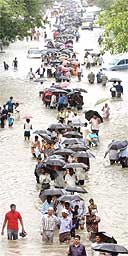The death toll from this week's record monsoon rains in western India has risen to almost 700, officials said today.
Around 370 of the 696 confirmed deaths were in Mumbai - formerly known as Bombay - and the surrounding area in Maharashtra state, officials at the government's emergency control room said.
Rumours that a dam had burst, which spread late yesterday, triggered a stampede in a slum in the north of the city, in which at least 15 people were trampled to death and another 25 injured.
On Tuesday, Mumbai, India's financial centre, was hit by 94cm of rain - the heaviest rainfall since India began keeping weather records in 1846.
Much of the rain came over just a few hours, transforming roads into torrents and triggering landslides that buried dozens of people and cut off villages.
The rains continued into Wednesday, paralysing Mumbai and devastating huge areas, but ended yesterday, leaving an overcast sky.
Government officials yesterday imposed a mandatory holiday, ordering all workers to stay at home and forcing the closure of banks and the stock exchange.
Most of the Mumbai victims drowned, were crushed by falling walls, or were electrocuted as they trod on exposed wires hidden under flood waters.
"I lost count of the number of people who were electrocuted. There were clusters of people who stepped on exposed wires," a relief worker said.
The Indian prime minister, Manmohan Singh, yesterday arrived in Mumbai and surveyed the flooding from a helicopter. Mr Singh announced an immediate 7bn rupee (£90m) aid package.
In the northern Mumbai suburb of Saki Naka, rescuers and survivors searched the ruins of a shantytown crushed when a hill collapsed on top of it. At least 110 people were killed and more than 45 others are missing, presumed dead.
Rescuers piled bodies onto trucks and flagged down private cars to carry dozens of injured people to hospitals.
Some neighbourhoods remained without electricity amid knee-deep flooding. Most roads had been cleared of hundreds of cars abandoned after they stalled in the rain.
Mumbai residents responded to the devastation by opening their homes and distributing food to motorists stuck in traffic. They also tied ropes across flooded roads to help people negotiate the waist-deep water.
"My car was flooded with water in less than five minutes," said Pallavi Jain, a 25-year-old computer programmer.
"I managed to get out, and just saw the car sink. There were two men in the car behind mine, and by the time people tried to open their door, it was too late. They couldn't do anything. The doors were jammed. It was awful."
State police officials said rescue teams were distributing food and drinking water to people marooned in villages cut off by floods.
